August 31, 2015 4:13 PM
Catch-22: Faculty and University Administration
I agree with Timothy Burke that the evolution of university administration is shaped in part by the unintended consequences of faculty behavior:
I think some of my colleagues across the country are potentially contributing to the creation of the distanced, professionalized, managerial administrations that they say that they despise, and they're doing it in part through half-voiced expectations about what an ideal administrator might be like.
This passage comes from Performing the Role, in which Burke discusses some of the fall-out from a botched faculty hiring at the University of Illinois last year. Even if you don't know much about the Salaita case, you may find Burke's piece worth reading. It captures pretty well how universities seem to be shifting toward a professionalized administrative class and the ways in which this shift clashes -- and meshes -- with faculty expectations and behavior.
This line, in particular, sums up a surprising amount of my experience as a department head for the last decade:
I think we somehow expect that administrative leaders should be unfailingly polite, deferential, patient, and solicitous when we're the ones talking with them and bold, confrontational, and aggressive when they're talking to anyone else.
The next one has affected me less directly, but I see it in the expectations across campus all the time:
We seem to expect administrative leaders to escape structural traps that we cannot imagine a way to escape from.
Burke ends the paragraph containing those sentences with a summary that many administrators can appreciate: "There's a lot of Catch-22 going on here."
Burke is always thoughtful, and thought-provoking, on matters of academia and culture. If those topics interest, his blog is often worth reading.
August 25, 2015 1:57 PM
The Art of Not Reading
The beginning of a new semester brings with it a crush of new things to read, write, and do, which means it's a good time to remember this advice from Arthur Schopenhauer:
Hence, in regard to our subject, the art of not reading is highly important. This consists in not taking a book into one's hand merely because it is interesting the great public at the time -- such as political or religious pamphlets, novels, poetry, and the like, which make a noise and reach perhaps several editions in their first and last years of existence. Remember rather that the man who writes for fools always finds a large public: and only read for a limited and definite time exclusively the works of great minds, those who surpass other men of all times and countries, and whom the voice of fame points to as such. These alone really educate and instruct.
"The man who writes for fools always finds a large public." You do not have to be part of it. Time is limited. Read something that matters.
The good news for me is that there is a lot of writing about compilers by great minds. This is, of course, also the bad news. Part of my job is to help my students navigate the preponderance of worthwhile readings.
Reading in my role as department head is an altogether different matter...
~~~~
The passage above is from On Books and Reading, which is available via Project Gutenberg, a wonderful source of many great works.
August 23, 2015 10:12 AM
Science Students Should Learn How to Program, and Do Research
Physicist, science blogger, and pop science author Chad Orzel offered some advice for prospective science students in a post on his Forbes blog last week. Among other things, he suggests that science students learn to program. Orzel is among many physics profs who integrate computer simulations into their introductory courses, using the Matter and Interactions curriculum (which you may recall reading about here in a post from 2007).
I like the way Orzel explains the approach to his students:
When we start doing programming, I tell students that this matters because there are only about a dozen problems in physics that you can readily solve exactly with pencil and paper, and many of them are not that interesting. And that goes double, maybe triple for engineering, where you can't get away with the simplifying spherical-cow approximations we're so fond of in physics. Any really interesting problem in any technical field is going to require some numerical simulation, and the sooner you learn to do that, the better.
This advice complements Astrachan's Law and its variants, which assert that we should not ask students to write a program if they can do the task by hand. Conversely, if they can't solve their problems by hand, then they should get comfortable writing programs that can. (Actually, that's the contrapositive of Astrachan, but "contrapositively" doesn't sound as good.) Programming is a medium for scientists, just as math is, and it becomes more important as they try to solve more challenging problems.
Orzel and Astrachan both know that the best way to learn to program is to have a problem you need a computer to solve. Curricula such as Matter and Interactions draw on this motivation and integrate computing directly into science courses. This is good news for us in computer science. Some of the students who learn how to program in their science courses find that they like it and want to learn more. We have just the courses they need to go deeper.
I concur with all five of Orzel's suggestions for prospective science students. They apply as well to computer science students as to those interested in the physical sciences. When I meet with prospective CS students and their families, I emphasize especially that students should get involved in research. Here is Orzel's take:
While you might think you love science based on your experience in classes, classwork is a pale imitation of actual science. One of my colleagues at Williams used a phrase that I love, and quote all the time, saying that "the hardest thing to teach new research students is that this is not a three-hour lab."
CS students can get involved in empirical research, but they also have the ability to write their own programs to explore their own ideas and interests. The world of open source software enables them to engage the discipline in ways that preceding generations could only have dreamed of. By doing empirical CS research with a professor or working on substantial programs that have users other than the creators, students can find out what computer science is really about -- and find out what they want to devote their lives to.
As Orzel points out, this is one of the ways in which small colleges are great for science students: undergrads can more readily become involved in research with their professors. This advantage extends to smaller public universities, too. In the past year, we have had undergrads do some challenging work on bioinformatics algorithms, motion virtual manipulatives, and system security. These students are having a qualitatively different learning experience than students who are only taking courses, and it is an experience that is open to all undergrad students in CS and the other sciences here.
August 19, 2015 4:07 PM
Working Too Much Means Never Having to Say "No"
Among the reasons David Heinemeier Hansson gives in his advice to Fire the Workaholics is that working too much is a sign of bad judgment:
If all you do is work, your value judgements are unlikely to be sound. Making good calls on "is it worth it?" is absolutely critical to great work. Missing out on life in general to put more hours in at the office screams "misguided values".
I agree, in two ways. First, as DHH says, working too much is itself a general indicator that your judgment is out of whack. Second is the more specific case:
For workaholics, doing more work always looks like a reasonable option. As a result, when you are trying to decide, "Should I make this or not?", you never have to choose not to make the something in question -- even when not making it is the right thing to do. That sort of indifferent decision making can be death in any creative endeavor.
Posted by Eugene Wallingford | Permalink | Categories: General, Software Development, Teaching and Learning
August 12, 2015 10:09 AM
Graphic Art: Links in Jewish Literature
"Genesis 1:1 is the Kevin Bacon of Sefaria."
This morning I finally read Sefaria in Gephi: Seeing Links in Jewish Literature, which had been in my reading list for a few months. In it, Liz Shayne introduces a collaborative project to visualize the relationships among 100,000+ sections of Jewish literature encoded in Sefaria, an online library of Jewish texts. It's a cool project, and the blog entries about it remind us how beautiful visualizations of graphs can be. I love this basic image, in which nodes represent sections of text, color indicates the type of text, and size corresponds to the degree of the node:
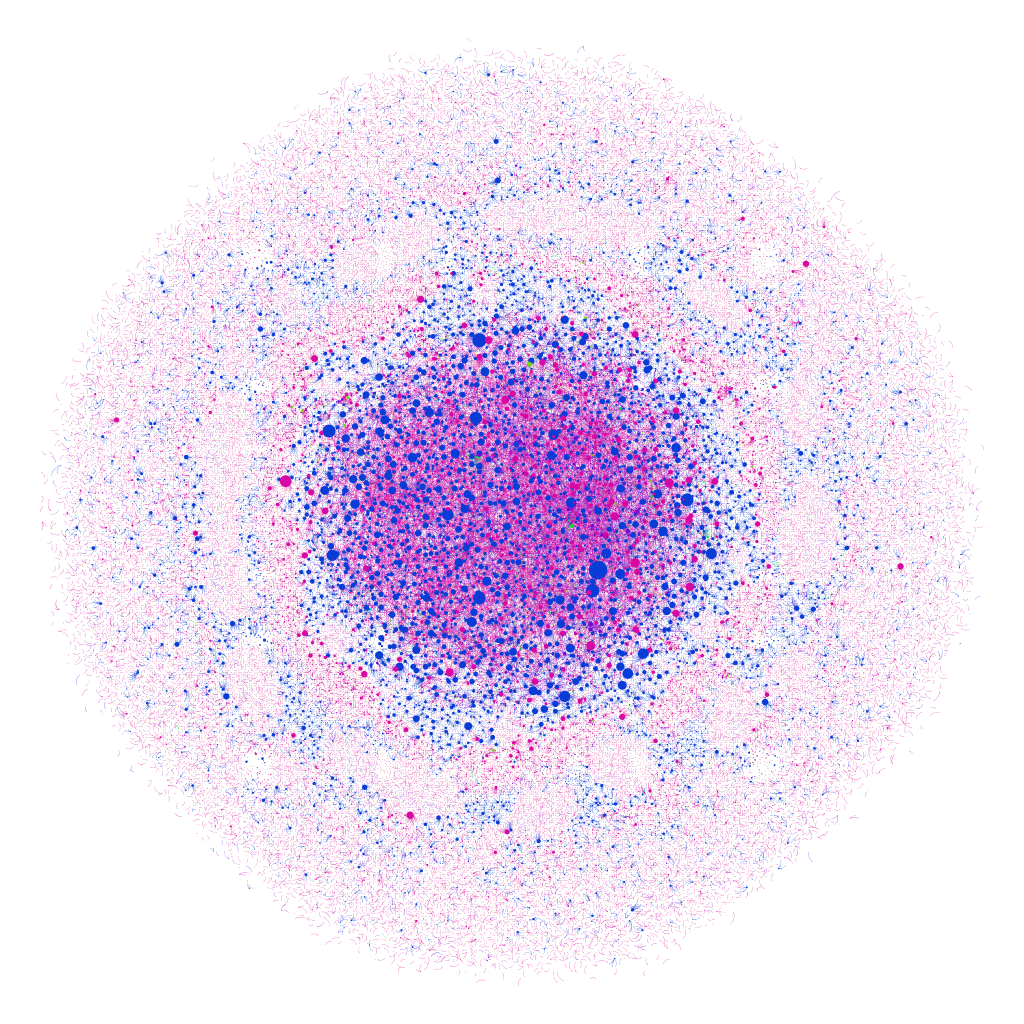 |
This is suitable for framing and would make a fine piece of art on my office wall.
Images like this can help us to understand a large dataset at a high level more easily than simply looking at the data themselves. Of course, creating the image requires some initial understanding, too. There is a give-and-take between analyzing the data and visualizing it that mutually reinforces our understanding.
As I mentioned in a December 2004 post, sometimes a computer scientist can produce a beautiful picture without intending to. One of my grad students, Nate Labelle, studied package dependencies in Linux as part of a project on power laws and open-source software. He created this image that shows the dependencies among one hundred randomly selected packages:
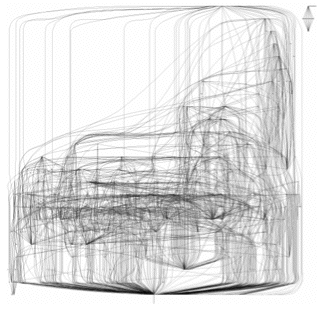 |
Unlike the neat concentric Sefaria image above, Nate's image has a messy asymmetry that reflects the more decentralized nature of the Linux ecosystem. It evokes for me a line drawing of a book whose pages are being riffled. After all these years, I still think it's an attractive image.
I have not read the rest of the Sefaria blog series, but peeking ahead I saw a neat example in Sefaria III: Comparative Graphing that shows the evolution of the crowd-sourced Sefaria dataset over the course of four months:
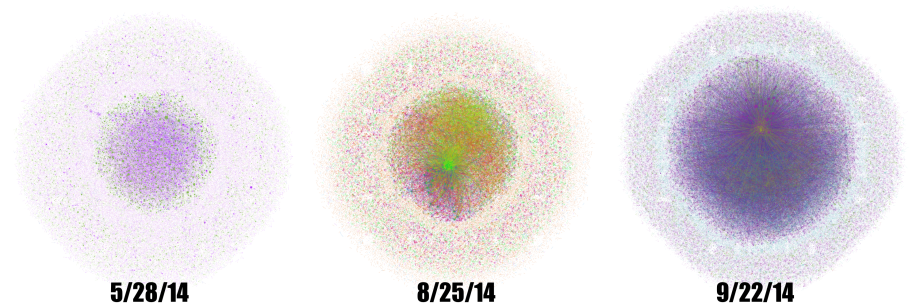 |
These images look almost like a time-lapse photograph of a supernova exploding ( video). They are pretty as art, and perhaps instructive about how the Sefaria community operates.
The Ludic Analytics site has links to two additional entries for the project [ II | IV ], but the latest is dated the end of 2014. I hope that Shayne or others involved with the project write more about their use of visualizations to understand the growing dataset. If nothing else, they may create more art for my walls.
August 06, 2015 10:22 AM
Not So Different
Trevor Blackwell on The Lessons of Viaweb:
[Scott Kirsner]: What was the biggest challenge you faced with Viaweb?
[Trevor Blackwell]: Focusing every day on the few things that mattered and not getting distracted by the hundreds of things that didn't.
Maybe the life of a department head isn't all that different from the life of an entrepreneur after all. Well, except for the $49 million.
August 04, 2015 1:00 PM
Concrete, Then Abstract
One of the things that ten years teaching the same topic has taught Daniel Lemire is that students generally learn more effectively when they learn practical skills first and only then confront the underlying theory:
Though I am probably biased, I find that it is a lot harder to take students from a theoretical understanding to a practical one... than to take someone with practical skills and teach him the theory. My instinct is that most people can more easily acquire an in-depth practical knowledge through practice (since the content is relevant) and they then can build on this knowledge to acquire the theory.
He summarizes the lesson he learned as:
A good example, well understood, is worth a hundred theorems.
My years of teaching have taught me similar lessons. I described a related idea in Examples First, Names Last: showing students examples of an idea before giving it a name.
Lemire's experience teaching XML and my experience teaching a number of topics, including the object-oriented programming example in that blog post, are specific examples of a pattern I usually call Concrete, Then Abstract. I have found this to be an effective strategy in my teaching and writing. I may have picked up the name from Ralph Johnson at ChiliPLoP 2003, where we were part of a hot topic group sketching programming patterns for beginning programmers. Ralph is a big proponent of showing concrete examples before introducing abstract ideas. You can see that in just about every pattern, paper, and book he has written.
My favorite example of "Concrete, Then Abstract" this week is in an old blog entry by Scott Vokes, Making Diagrams with Graphviz. I recently came back to an idea I've had on hold for a while: using Graphviz to generate a diagram showing all of my department's courses and prerequisites. Whenever I return to Graphviz after time away, I bypass its documentation for a while and pull up instead a cached link to Scott's short introduction. I immediately scroll down to this sample program written in Graphviz's language, DOT:
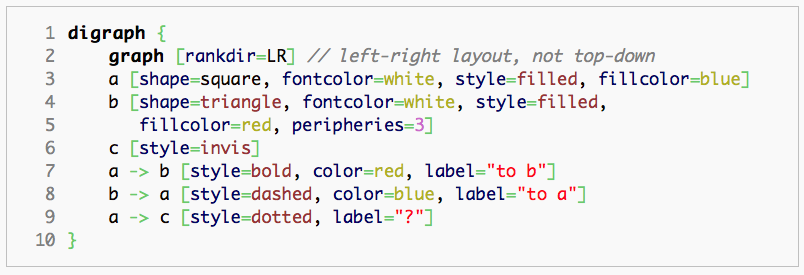 |
... and the corresponding diagram produced by Graphviz:
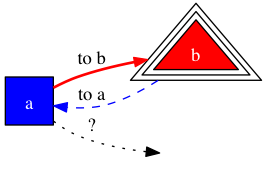 |
This example makes me happy, and productive quickly. It demonstrates an assortment of the possibilities available in DOT, including several specific attributes, and shows how they are rendered by Graphviz. With this example as a starting point, I can experiment with variations of my own. If I ever want or need more, I dig deeper and review the grammar of DOT in more detail. By that time, I have a pretty good practical understanding of how the language works, which makes remembering how the grammar works easier.
Sometimes, the abstract idea to learn, or re-learn, is a context-free grammar. Sometimes, it's a rule for solving a class of problems or a design pattern. And sometimes, it's a theorem or a theory. In all these cases, examples provide hooks that help us learn an abstract idea that is initially hard for us to hold in our heads.